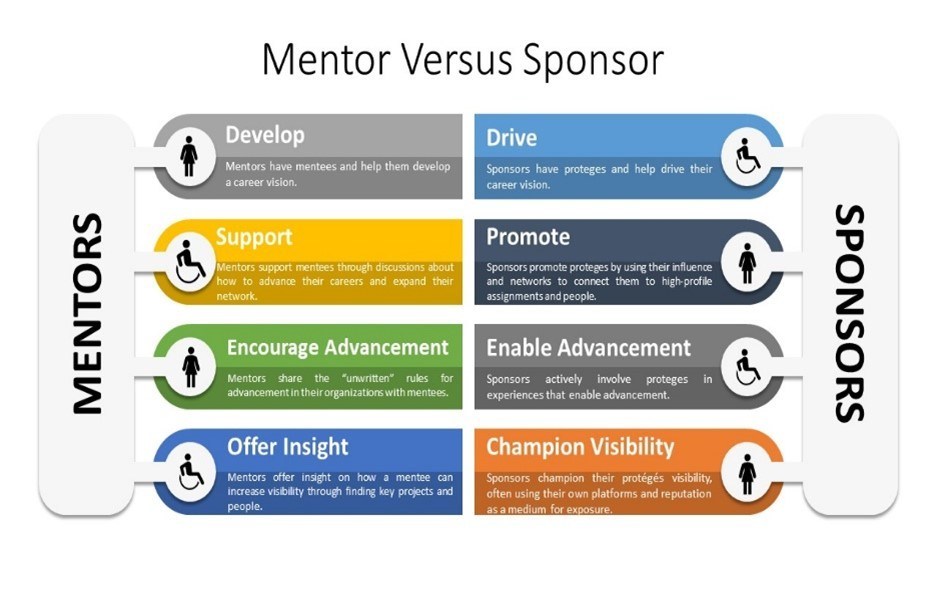Moving from Mentorship to Sponsorship: Securing New Seats at the Table
November 23, 2020 in Diversity & Inclusion, Keeping Up with Human Capital, Relationships & Networking
By Joy Oguntimein, Autumn Thomas

Though the terms mentor and sponsor are commonly used interchangeably, there are clear differences between the two. Almost anyone can be a mentor, but only those with access to positions of power and leadership, and the ability to improve the visibility of those they sponsor, can serve as sponsors. Mentorship can be looked at as the coaching that goes on behind the scenes and the brainstorming around career directions. Sponsorship, on the other hand, is literally joining up your reputation with someone else — leveraging your social or professional capital to champion the development of a protégé or, said differently, putting some skin in the game! Sponsors actively open doors, create opportunities for visibility, and advocate for their protégé to maximize their career growth and potential. To become a sponsor, one must acknowledge the power dynamics inherent to any organization. Furthermore, a sponsor must be willing to use their power, social capital, and credibility to promote and protect their protégé.
In today’s blog we are focusing on sponsorship, specifically exploring the ways in which sponsorship can be used as a tool to improve the professional development of women and minorities. For more information on mentorship, read Diversifying Mentorship: Research and Best Practice by FMP’s own Thuy Truong and Caitlin Rogers.
What Do Sponsors Do?
Sponsors can be thought of as workplace advocates. They go beyond the social, emotional, and personal growth development traditionally provided by many mentors and instead actively look for opportunities that advance, elevate, and highlight the skills of their protégé for career advancement.[1] Sponsors not only advise their protégés, they promote, protect, prepare, and push them. Outlined below are four action steps you can take as a sponsor to support women and minorities in the workplace who are 54% less likely than their male counterparts to have a sponsor help them navigate the inevitable success and challenges within their career[2].
Say Their Name
Sponsors actively help advance a protégé’s career. This relationship is high-stakes for both the sponsor- who puts their reputation on the line- and the protégé- who must deliver quality results. Sponsors openly recommend high-performing employees for challenging assignments, promising opportunities, and key promotions. In essence sponsors say, “I think [insert name] should be considered for the [role, task, or promotion].” This strategic support is particularly impactful for the careers of women and minorities who often remain behind men, even with mentoring.[3] Sponsors can supercharge a person’s career by saying their name, which may provide access to essential networks, recognition of achievement from senior-level executives, and recommendation for key assignments.
Demystify the Power
Imposter syndrome (IS) can act as a major obstacle to career progression, especially for women and minorities. IS is a pattern of behaviors and thoughts where people doubt their accomplishments and have a persistent, often internalized fear of being exposed as a fraud[4]. An estimated 70% of the US population suffers from imposter syndrome, though female leaders struggle more with imposter syndrome than men[5]. One action a sponsor can do to support career progression is to demonstrate for women and minorities that they belong in executive roles. A sponsor shows a protégé that they belong by inviting them to executive meetings and assigning executive level tasks. For example, a sponsor may ask a protégé to develop the agenda or facilitate a meeting. The goal is to allow a person to see themselves in the place they want to be and demystify what it takes to get there. These opportunities also put a spotlight on the individual.
Share the Stage
A sponsor ‘shares the stage’ with their sponsored individual by actively identifying career-expanding opportunities that allow the individual to showcase their skills. Sponsors are familiar with their protégé’s quality of work and are thus able to identify suitable stretch opportunities that align with their talents and expertise. For example, a sponsor may invite a protégé to a senior leader meeting so they can present a new business opportunity they’ve been developing.
Give Up Your Seat at the Table
As previously mentioned, part of being a sponsor is understanding the power dynamics inherent in the workplace and the reality that women and minorities traditionally have not been afforded the same opportunities as their white male counterparts. According to McKinsey’s 2020 Women in the Workplace report, women in senior leadership positions remain underrepresented in corporate America. Despite occupying 47% of entry-level position, they only represent 28% of senior management positions compared to their male counterparts who occupy 59%. The numbers are especially staggering when disaggregated by race, as white women account for 23% of senior management positions while women of color, which include Black, Asian, and Latinas, account for 5%. When there is no more room at the table, the sponsor gives up their seat at the table. No one knows this better than Reddit co-founder, Alexis Ohanian, who recently resigned from his company’s board and asked to be replaced by a Black candidate. When a sponsor gives up their seat at the table, it demonstrates to the protégé and other senior leaders the depth of confidence they have in their protégé’s skills and abilities. Not all sponsors may be in the position to relinquish a board seat, but they are ultimately tasked with building the network of their protégé by sharing their own.
Final Thoughts
There is no magic lever for success, but there are individuals- mentors and sponsors- who can help guide and propel us into new opportunities that enhance our growth and development.
If you are a senior-level executive, continue to mentor junior employees, but be open to sponsorship as a method to provide enhanced support and exposure to high-performing individuals often underrepresented in leadership positions. As you look to identify these individuals, ask yourself:
- Who has a career vision I want to invest in?
- Who do I want to advocate and champion among other company leaders?
- Who has not had a highly visible leadership role or assignment, but has demonstrated that they are capable?
For mid-level professionals, know that sponsorship is a professional tool to help drive your success. If you want a seat at the table, consider the following questions as you look to identify those within your organization who may be willing to pull you up a chair:
- Which senior leader has a network (or platform) most equipped to help me advance in my development?
- Who makes pay, promotion, or project assignment decisions that affect my career?
- Which senior leaders could benefit from my career advancement?
Have you participated in a sponsorship? Share your experiences with us on LinkedIn!

Joy Oguntimein, a Senior Consultant in FMP’s Learning and Development Center of Excellence, is a happiness activator sprinkling compassion and humor wherever she goes. When she isn’t designing fun learning experiences, getting creative with learning innovations, or sharing learning and development best practices, you can find her volunteering with groups providing services to those experiencing homelessness, writing, or trying to solve a crime on TV.

Autumn Thomas is a Consultant in the Technology, Analytics, and Transformation Center of Excellence. Having graduated from Florida State University with a Master of Science degree in International and Comparative Education Studies, she has dedicated her career to helping those from underserved communities improve their access to equitable opportunities in systematic ways while also consulting with stakeholders to do more efficient and impactful work.
References:
[1] The benefits of mentoring have been detailed thoroughly and include: personal support, role modeling and friendship: Judith Worell, Encyclopedia of Women and Gender: Sex Similarities and Differences and the Impact of Society on Gender, L-Z Vol. 2 (London, UK: Academic Press, 2002); increased organizational commitment: Belle Rose Ragins, John L. Cotton, and Janice S. Miller, “Marginal Mentoring: The Effects of Type of Mentor, Quality of Relationship, and Program Design on Work and Career Attitudes,” Academy of Management Journal, vol. 43, no. 6 (December 2000): p. 1177- 1194; reduced turnover intentions: Terri A. Scandura and Ralph E. Viator, “Mentoring in Public Accounting Firms: An Analysis of Mentor-Protégé Relationships, Mentorship Functions, and Protégé Turnover Intentions,” Accounting, Organizations & Society, vol. 19, no. 8 (November 1994): p. 717-734; increased promotion opportunities: Terri A. Scandura, “Mentorship and Career Mobility: An Empirical Investigation,” Journal of Organizational Behavior, vol. 13, no. 2 (March 1992): p.169-174; and decreased stress: Sarah Coles, “Build a Better Boss,” Employee Benefits (December 2001): p. 37-38. Much of the literature has conceived of sponsorship as a sub-function of mentoring. For an exception, see Earnest Friday, Shawnta S. Friday, and Anna L. Green, “A Reconceptualization of Mentoring and Sponsoring,” Management Decision, vol. 42, no. 5 (2004): pp. 628-644. See also Joanna Barsh and Susie Cranston, How Remarkable Women Lead (New York: Crown Business, 2009): pp. 165-173
[2] Berhane, Sava. “Why Women Need Career Sponsors More Than Mentors.” Fast Company, Fast Company, 6 Nov. 2015, www.fastcompany.com/3050430/why-women-need-career-sponsors-more-than-mentors.
[3] Carter and Silva; Sylvia Ann Hewlett, Kerrie Peraino, Laura Sherbin, and Karen Sumberg, The Sponsor Effect: Breaking Through the Last Glass Ceiling, Harvard Business Review Research Report (December 2010)
[4] Dalla-Camina, Megan. “The Reality of Imposter Syndrome.” Psychology Today, Sussex Publishers, 3 Sept. 2018, www.psychologytoday.com/us/blog/real-women/201809/the-reality-imposter-syndrome.
[5] Gopal, Shivani. “Why Imposter Syndrome Affects the Most Successful People.” Medium, Medium, 20 Oct. 2019, medium.com/datadriveninvestor/why-imposter-syndrome-affects-the-most-successful-people-d3e5c8bb977e.